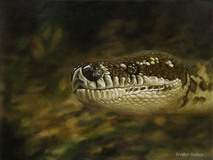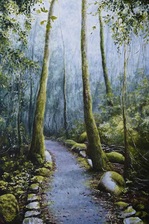The Art of Roslyn Oakes
Murwillumbah
|
Silent Flight
Sold The Australian Barn Owl, Tyto alba deliculata (meaning 'the delicate white owl') is well known for its ghostly beauty and silent flight. Contrasted to that, its calls vary from a breathy hiss to an unearthly shriek. The Barn owl is one of the most wide-spread of all land birds, being found on all continents (except Antarctica). Their favourite food is the common house mouse and introduced rat species which sadly contributes to the owls demise every year due to secondary poisoning as a direct result of human pest control methods. < back |
|
Ancient Relics
Sold The Antarctic Beech tree grows in cool temperate rainforests from Barrington Tops to the caldera's higher altitude national parks. It is a remnant from the ancient Gondwana super continent when Australia, South America and Antarctica where connected. It can grow up to 50 metres in height, and usually reproduces by coppicing from a 'mother' tree with specimens such as this one being over a thousand years old - festooned with mosses and epiphytes. The colourful Noisy Pitta forages through the moist, decomposing leaf litter of the forest floor in search of grubs and insects. It usually nests in well hidden nooks within the buttresses of rainforest trees. < back |
|
Carpet Python Study
$590 The intriguing carpet python is relatively common in the caldera region and found in a variety of habitats, including rainforests. They occasionally take up residence in sheds and roofs of houses (especially in winter) and are adept at catching mice and rats. I hope that more people will come to appreciate these beautiful and elegant animals, as I do, and give them the respect they deserve. < back |
|
Water Lily & Frog Study
$590 The difference between water lilies and lotus plants is that the leaves of the water lily sit on the water while the lotus leaves grow up to four feet above the water. Water lilies are a freshwater perennial herbs that grow in temperate and tropical climates around the world and commonly seen in dams and estuaries around the caldera region. They make an excellent protective habitat for many creatures such as frogs. I found this subject irresistible to paint due to the morning light producing an almost luminescent glow to the leaves and flower. < back |
|
Catch of the Day
$700 The Osprey is frequently seen along rivers, estuaries and beaches of the caldera region. A highly adapted fish eagle, it will catch several fish each day, especially when dependant young need to be fed. It is depicted here with the first catch of the day, plucked from the cool waters of the Tweed River on a winters morning. < back |
|
Peanut Tree - Red-Fruited Kurrajong
Sold This rainforest tree usually grows to a height of about five to ten metres. The greenish-yellow flowers appear from November through to January. The seed pods are bright orange or pink-red when ripe and contain up to eight shiny black seeds which are edible, tasting like raw peanuts. The bark of the Peanut Tree Sterculia quadrifida was used by aboriginal people in their traditional weaving techniques to make baskets used to hold other fruits and seeds collected from the rainforests of the caldera region. < back |
|
Misty Meanderings
$850 This painting depicts part of the trail on the way to the Best Of All lookout and is one of the many walking trails within the Springbrook National Park. Located on the northern rim of the Tweed caldera, Springbrook is known for spectacular waterfalls, lush rainforest, ancient Antarctic Beech trees, impressive views and significant biodiversity. The park covers 6725 hectares and include the Springbrook Plateau, Mount Cougal and Natural Bridge sections. During the wet season, these high altitude rainforests are often shrouded in mists providing an excellent opportunity for an 'atmospheric' painting. The foreground colours become muted as the well formed track disappears around a bend. < back |
|
Grab Hold and Don't let Go
Sold Strangler figs provide a habitat for a vast variety of invertebrates as well as rodents, bats, reptiles, amphibians and birds. Wildlife is attracted to the canopy in particular because of its nutritious fruit. The rainforests of the caldera region have several species of strangler figs. Individuals may reach 60 m in height. Their life cycle is remarkable. Seed germination usually takes place in the canopy of a host tree with the seedling then living as an epiphyte until its roots establish contact with the ground many metres below. These then enlarge and weave a network of strangling ‘arms’ around the trunk of its host, eventually becoming a freestanding tree. < back |
|
Watching Me, Watching You
$900 The Tawny Frogmouth, often mistakenly considered as an owl, is more closely related to the nightjars which are also ground feeding masters of camouflage. During the day they generally perch unobtrusively in a tree, their plumage and posture resembling a dead branch. It is found throughout Australia (including Tasmania) and is often seen around the caldera region on dusk while its out hunting. Unfortunately these birds are often hit by cars while chasing insects which have been attracted by streetlights and vehicle headlights. < back |
|
Rainforest View
NFS The Gondwana Rainforests of Australia spill across fifty separate parks in northern New South Wales and South East Queensland. Rainforest is the most diverse ecosystem on earth yet it only covers 6% of the world’s surface. If this vital ecosystem is to survive, remaining areas of rainforest must be protected. Three quarters of New South Wales rainforest have disappeared since European settlement. The remnants of old Gondwanaland that carry with them still the breath of paradise, since now it seems agreed that Eden must have been a rainforest. < back |

|
Barred Romance
$690 The Great Barred Frog Mixophyes fasciolatus inhabits rainforests, Antarctic beech forests or wet sclerophyll forests of the caldera region. It breeds in both streams and ponds and calls from the surrounding land with a very loud "wark-wark-wark". The male and female Great Barred Frog will enter the water for amplexus (external egg fertilisation by close contact). Interestingly, after laying the eggs, the female will flick them onto the bank for development. The eggs will then be washed into the stream or pond after the first rain, and hatch into tadpoles. All reference frog images courtesy of John Pumpurs. < back |
|
Fallen Warriors
Sold The Eastern Water Dragon is often seen basking on rocks or logs, sometimes well away from the waters' edge. They may become quite used to human presence. The grounds of the Murwillumbah Visitors Centre (CAG) usually has several resident individuals co-habiting. The male is particularly colourful with a red splash of colour under his throat and chest, especially prominent during the breeding season. This one was so preoccupied with sunbaking that he hardly noticed me taking his photograph as a reference to my painting. < back Contact Roslyn Roslyn's website |











